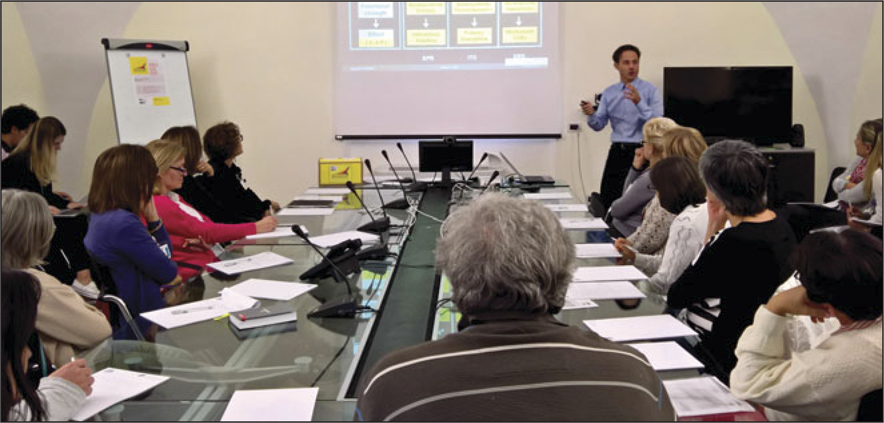In early October 2017, the first meeting for “Boost-Up the New Generation of Materials Scientists” took place at the Center for Nanotechnology Innovation (CNI) in Pisa, Italy. The initiative originated with Valerio Voliani, a researcher at one of the national centers of the Istituto Italiano di Tecnologia (IIT). The institute was created with the objective of promoting Italy’s technological development and higher education in science and technology.
Voliani aims to transfer the latest materials research results and tools to the next generation. Undergraduate students and high-school teachers in Pisa and Livorno were involved in two different activities. The first strives to allow researchers and teachers to work more closely together by exchanging knowledge on advanced materials science. The second permits students to work directly in research laboratories.

Top: Valerio Voliani (center) with a group of educators on the first day of the Boost-Up workshop in Pisa, Italy. Bottom right: One of the educational kits used during the first day of the Boost-Up workshop. Credits: A. Russo, Istituto Italiano di Tecnologia.
Participants include three high schools from each Pisa and Livorno, 34 schoolteachers, and 40 undergraduate students. At the first meeting, teachers attended seminars on various topics and techniques related to materials science:
-
▪ Advanced microscopy that allows one to see atoms and nanocrystals, with Mauro Gemmi, coordinator at CNI
-
▪ The thinnest material in the world, graphene, with Camilla Coletti, tenure track researcher at IIT actively involved in the European initiative Graphene Flagship
-
▪ Structural biophysics and the ability to construct artificial structures through proteins, with Gianpiero Garau, IIT team leader
-
▪ Nanotechnologies applied to medicine, with Voliani.
The Materials Research Society (MRS) Foundation provided funding through a grassroots grant for the teachers’ kits used to perform nanomaterial investigations in their fourth and fifth grade classes. The experiments include synthesis of gold nanoparticles with pineapple juice, synthesis of iron nanoparticles for environment remediation, synthesis of a photonic crystal, crystallization of proteins and materials for the observation of solutions of different noble metal nanoparticles, and chemical vapor deposition growth graphene on copper. The funding also enabled updating teachers, who may potentially spread the knowledge to approximately 8000 students in the next several years, on cutting-edge research in materials science. “I have seen very interested and motivated teachers, which is awesome!” said Voliani.
In November, approximately 40 students will spend a full day in contact with IIT researchers, observing lab activities and learning some key concepts of scientific method and materials science research. In particular, they will visit the laboratory, use transmission electron microscopy to observe the nanoparticles they have synthesized using the experimental kits, observe cells using confocal microscopy, observe the synthesis of chemical vapor deposition grown graphene and its characterization by Raman spectroscopy and atomic force microscopy, and employ recombinant DNA technology for protein production.
IIT hopes to increase the interaction between academia and local high schools; recognize and support future-generation scientists; and improve the knowledge of materials science educators. In Italy, science education in the public school system—in particular, materials science—is under-taught and poorly perceived. As a result, instructors with an out-of-date education are teaching these subjects, causing both disorder in the educational system and the loss of promising students, as they choose not to continue academic coursework in scientific fields or even in academia. By educating the teachers on novel materials (nanostructures and 2D materials), they may then pass this information onto their students, and these students can strengthen and improve their problem-solving and critical-thinking skills. “I hope this project will improve the perception of science in the next generation. Maybe we will boost-up new materials scientists!” said Voliani.

Gianpiero Garau, Istituto Italiano di Technologia (IIT) team leader, presenting information to the teachers at the Boost-Up workshop. Credit: A. Russo, IIT.
Through the Boost-Up program and the MRS grant, the goal is to have a long-term collaboration between local high schools in Italy and academia, which will attract students to scientific subjects and raise awareness of novel materials.
The Materials Research Society Foundation supports grassroots grants to allow initia-tives that broaden the impact within and outside of the materials community.

